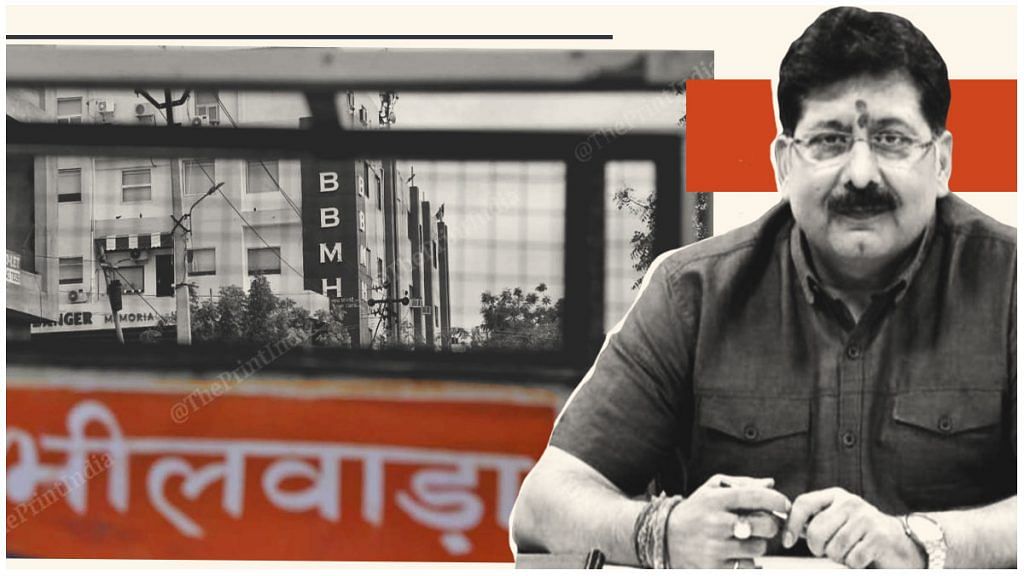New Delhi: The ‘Bhilwara model’ has been so successful in curbing the spread of Covid-19 in a hotspot that the central government has asked states to replicate its mantra of “ruthless containment”. But Bhilwara’s 56-year-old collector/district magistrate, who was in charge of implementing the plan and has been credited with its conceptualisation, remained cautious about declaring victory just yet.
“I think we have to wait until 1 May to be sure that we’ve completely eliminated the virus,” Rajendra Bhatt told ThePrint.
“I want that three cycles of isolation, testing and quarantining should be complete before we can claim victory.”
The textile town of Bhilwara in Rajasthan had become one of the hotspots of the Covid-19 outbreak, registering 27 positive cases and two deaths.
But the strategy adopted by the district administration has ensured that Bhilwara has not registered any new Covid-19 cases in 10 days, and chief secretaries of all states are now seeking to emulate it.
Bhatt humbly claimed the success was no “rocket science”. “We got full cooperation from the state government. When we (at the district level) said that we need to seal the border, the government did it immediately — no questions asked,” he said.
“When we said we cannot let anyone enter the district or leave their homes within the district, the government did it immediately. The Epidemic Act was imposed immediately giving the DM all the powers to take over hospitals, hotels, etc. So, it was a joint effort,” he added.
But while Bhatt credits his superiors and subordinates for the “joint effort”, officials in Rajasthan, including those from Bhatt’s team, say he is a DM like no other.
Also read: This is the ‘Bhilwara model’ Modi govt is looking to use across India to fight Covid-19
‘Everyone followed his instructions’
A young IAS officer from Rajasthan said, “He has been promoted from the Rajasthan state service to the IAS… I would say he is way better than the direct recruits of the IAS.”
Collector/district magistrate is usually the second posting of an IAS officer’s career, so the average age for the post is 28-30 years. But being from the Rajasthan state service, Bhatt became DM decades into his career. He was promoted to the IAS in 2007, and is set to retire in the next four years.
In every state, the ratio of IAS officers recruited directly and those promoted from the state services is 2:1.
The young officer quoted above continued: “It felt like Bhilwara was preparing for this kind of an eventuality over the last year or more, since Bhatt became DM. His rapport with the SP, the police, the state government, the SDMs etc. was such that everyone followed his instructions to the T.”
Also read: Reporting from Bhilwara was scary as the enemy was invisible. It was a virus
Embedded in the system
From isolating the district to mapping the hotspots, conducting door-to-door screening and aggressive contact tracing, ramping up quarantine and isolation wards to readying a monitoring mechanism for rural areas — the instructions from the DM’s office were real-time and unambiguous, officers said.
“The fact that he has so many years of experience and he is so embedded in the system in the state helped,” said another IAS officer working under Bhatt. “He would give directions, and we would just follow, and everything went on smoothly.”
Bhatt acknowledged the officer’s comment about him being embedded in the system.
“I’ve worked in the cooperative service all my life… I know how the supply and demand works in the rural and urban parts of Rajasthan, so all that experience was very useful to me,” Bhatt said.
“Before announcing the complete curfew, we sent our people to dairies, surveyed how much milk each household is consuming,” he said. “So that when we imposed the curfew, all we had to do is deliver an average amount to each house… Again, it was no rocket science.”
While IAS officers selected through direct recruitment are known to have more exposure in terms of governance, Bhatt’s model of governance at the time of a pandemic is being adopted by officers across the country, said a Rajasthan service officer.
“It is a matter of pride for all state civil services and a reminder that ‘direct recruits’ and ‘promotees’ are ultimately just tags,” this officer said.
Also read: How Bhilwara is dealing with its coronavirus problem — Full details of the district’s plan
